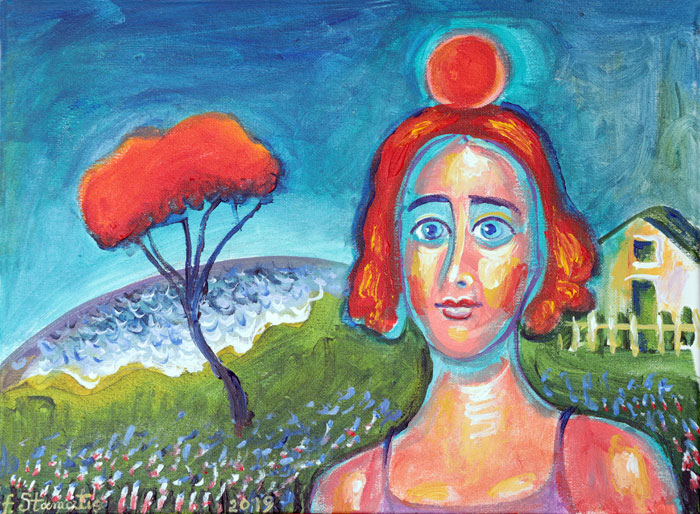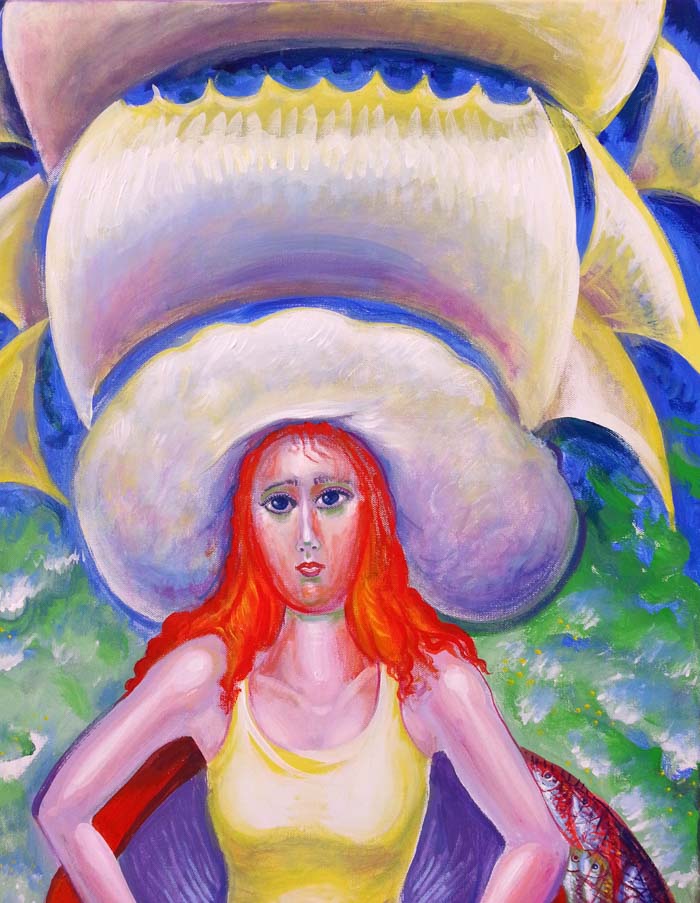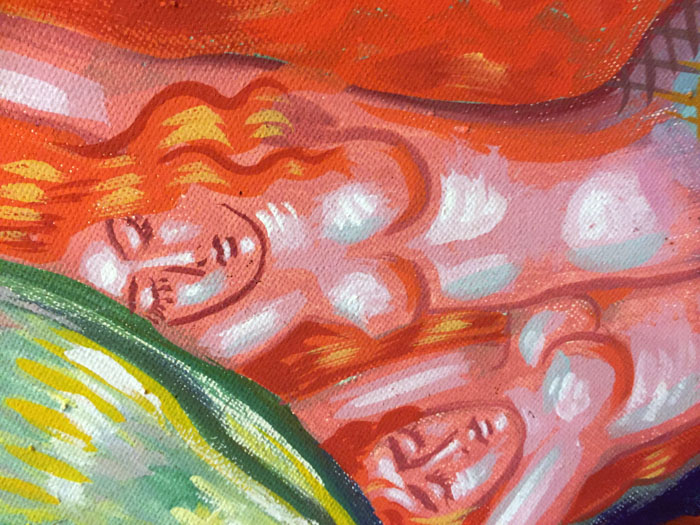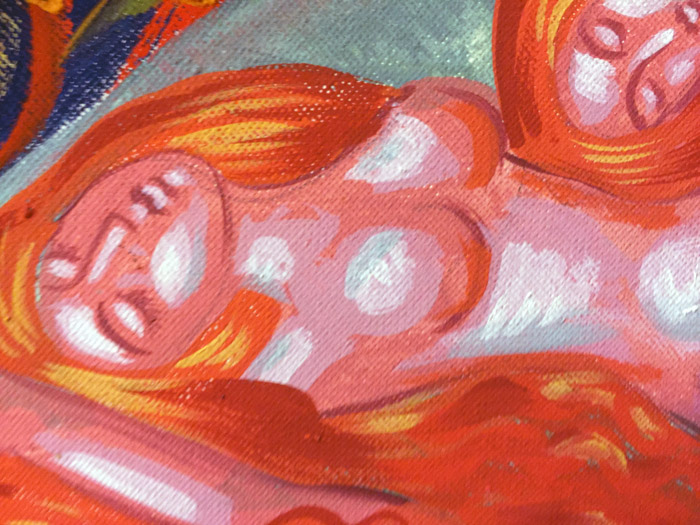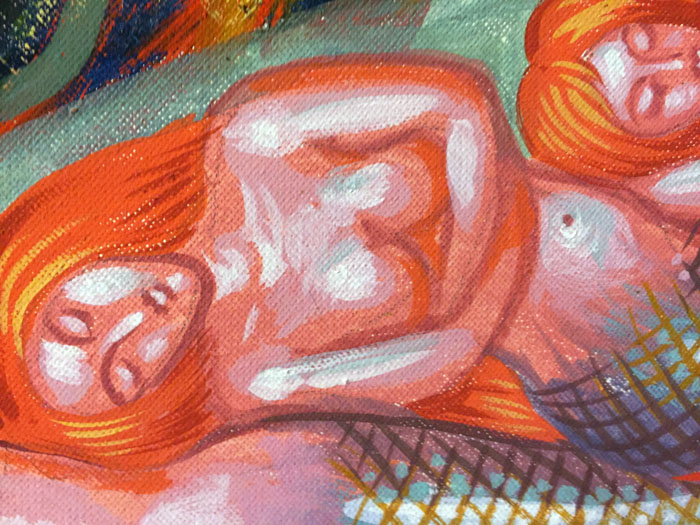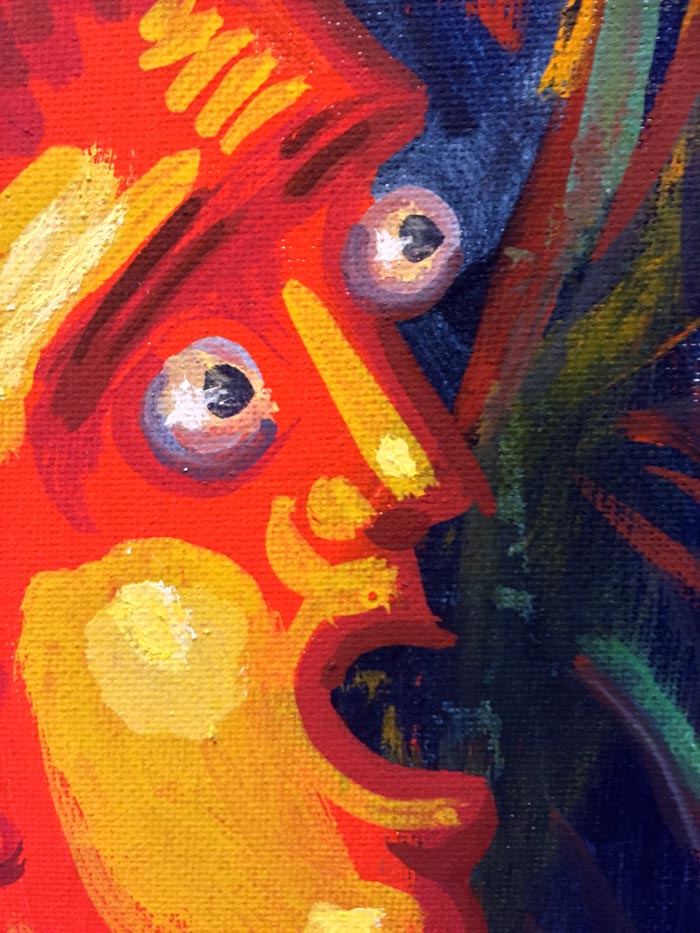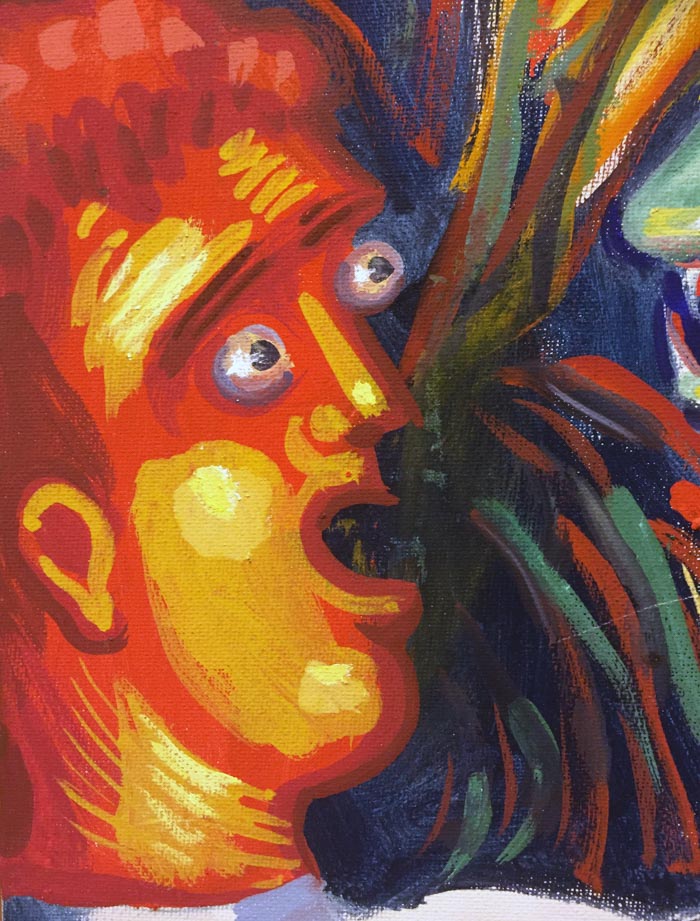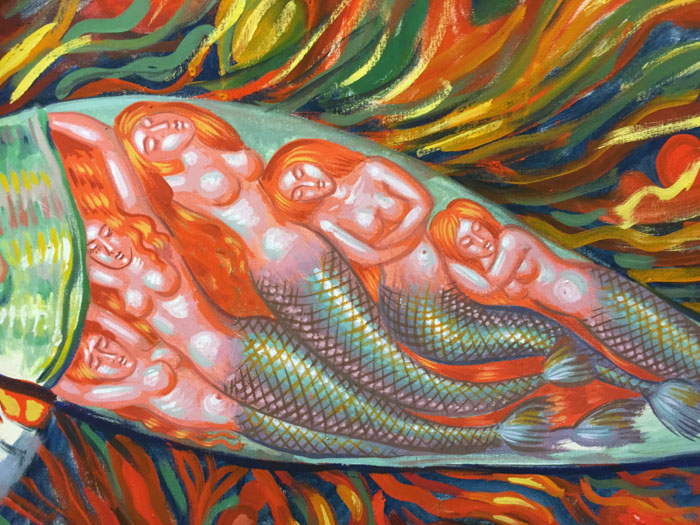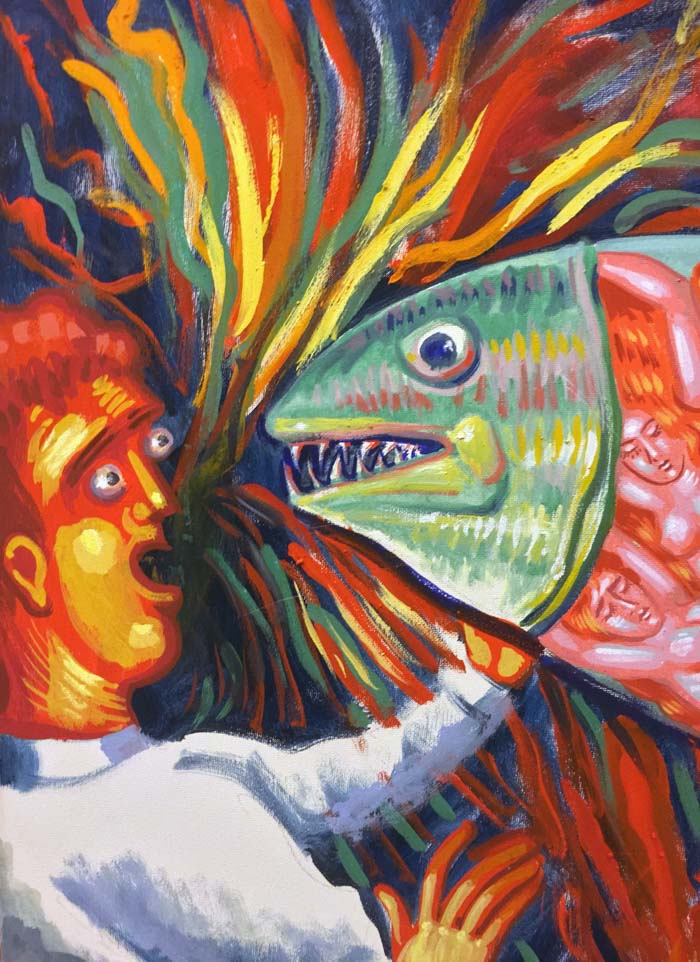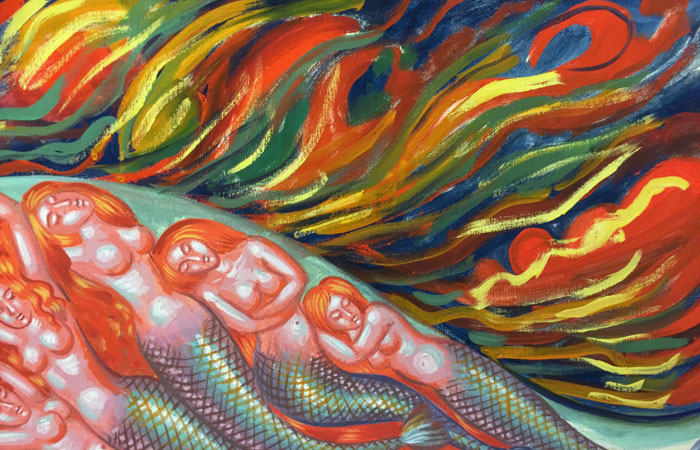- Details
- Category: Expressionism
"Stalker", acrylic on canvas, Stamatis Skliris, 2023
Tarkovsky’s “Stalker” is a quirky, somewhat brooding, and introverted character, introduced in a previous scene where his daughter intently stares at a glass on the table, which begins to shake and move on its own. Stalker is tasked with leading three friends to the supposed “House of Truth,” a place where it is said that whoever enters discovers the real truth about their existence. To the left of the scene, a pink path leads them to the upper left of the frame, towards a house marked by a “narrow and narrow gate that leads to the truth.” Their journey takes them through a murky, labyrinthine green forest. In this setting, Stalker anxiously tries to discern the revealing paths with his searching gaze, vital to understanding the painting's meaning, symbolizing the unraveling of our destiny’s enigma. Intriguingly, the destiny is ultimately ignored by one of the three friends, who believes he loves his sick brother and wants him to live. However, upon reaching the House of Truth, he learns of his brother's death.
Tarkovsky’s “Stalker” is a quirky, somewhat brooding, and introverted character, introduced in a previous scene where his daughter intently stares at a glass on the table, which begins to shake and move on its own. Stalker is tasked with leading three friends to the supposed “House of Truth,” a place where it is said that whoever enters discovers the real truth about their existence. To the left of the scene, a pink path leads them to the upper left of the frame, towards a house marked by a “narrow and narrow gate that leads to the truth.” Their journey takes them through a murky, labyrinthine green forest. In this setting, Stalker anxiously tries to discern the revealing paths with his searching gaze, vital to understanding the painting's meaning, symbolizing the unraveling of our destiny’s enigma. Intriguingly, the destiny is ultimately ignored by one of the three friends, who believes he loves his sick brother and wants him to live. However, upon reaching the House of Truth, he learns of his brother's death.
- Details
- Category: Expressionism
"Antigone and the Spirit of Tragedy", acrylic on canvas, 2020, 39x47 inch
Antigone (Ancient Greek: Ἀντιγόνη) is an Athenian tragedy written by Sophocles in (or before) 441 BC and first performed at the Festival of Dionysus of the same year. The true tragic hero of the play Antigone is the main character, Antigone, who accepts her execution in retaliation for an unjust law she knowingly broke. Her loyalty is her greatest weakness but a virtuous weakness, making her a tragic hero. The conflict at the heart of the play is between Creon and Antigone. Creon believes that Polynices should not receive a proper burial due to his role in assaulting the city of Thebes. Antigone loves her brother and wishes his soul to find peace. She violates Creon's decree, burying Polynices. In death, Antigone looks forward to being reunited with her brother Polynices, her father, Oedipus, and her mother, Jocasta. She is intense, passionate, and full of love; sometimes to a fault; she feels a heaviness of duty to her family name and the Gods, and to her, they are the same; fearless and thoughtful, takes risks, and is quick to judge; empowered by her defiance, she is proud, sensitive, and open.
Antigone (Ancient Greek: Ἀντιγόνη) is an Athenian tragedy written by Sophocles in (or before) 441 BC and first performed at the Festival of Dionysus of the same year. The true tragic hero of the play Antigone is the main character, Antigone, who accepts her execution in retaliation for an unjust law she knowingly broke. Her loyalty is her greatest weakness but a virtuous weakness, making her a tragic hero. The conflict at the heart of the play is between Creon and Antigone. Creon believes that Polynices should not receive a proper burial due to his role in assaulting the city of Thebes. Antigone loves her brother and wishes his soul to find peace. She violates Creon's decree, burying Polynices. In death, Antigone looks forward to being reunited with her brother Polynices, her father, Oedipus, and her mother, Jocasta. She is intense, passionate, and full of love; sometimes to a fault; she feels a heaviness of duty to her family name and the Gods, and to her, they are the same; fearless and thoughtful, takes risks, and is quick to judge; empowered by her defiance, she is proud, sensitive, and open.
- Details
- Category: Expressionism
"Mother—Study of the Ambivalence of MANNA in the Short Stories of Alexandre Papadiamantis", Stamatis Skliris, 2023
- Details
- Category: Expressionism
“Psychotherapist and Psychotherapeuted (healed),” acrylic on canvas, 2009, 100x70
Π141. Ο Ψυχοθεραπευτής και Ψυχοθεραπευόμενος ΙΙ, 2009, ακρυλικό σε μουσαμά, 100*70
Π141. Ο Ψυχοθεραπευτής και Ψυχοθεραπευόμενος ΙΙ, 2009, ακρυλικό σε μουσαμά, 100*70
- Details
- Category: Expressionism
“Psychotherapist and Psychotherapeuted”, acrylic on canvas, 2009, 75x60
Π120 - Ψυχοθεραπευτής και Ψυχοθεραπευόμενος, 2009, ακρυλικό σε μουσαμά, 75*60
Π120 - Ψυχοθεραπευτής και Ψυχοθεραπευόμενος, 2009, ακρυλικό σε μουσαμά, 75*60
- Details
- Category: Expressionism
“Woman in the Mirror of a Psychotherapist”, acrylic on canvas, 2009, 70x60
Π139 - Η γυναίκα στον καθρέπτη του ψυχαναλυτή , 2009, ακρυλικό σε μουσαμά, 70*60
Π139 - Η γυναίκα στον καθρέπτη του ψυχαναλυτή , 2009, ακρυλικό σε μουσαμά, 70*60
- Details
- Category: Expressionism
”Double Nightmare”, acrylic on canvas, 2010, 70x100
Π126 - Διπλός Εφιάλτης, 2010, ακρυλικό σε μουσαμά, 70*100
Π126 - Διπλός Εφιάλτης, 2010, ακρυλικό σε μουσαμά, 70*100
- Details
- Category: Expressionism
“The Little Prince: My Love, which Planet Do You Live On?”, acrylic on canvas, 2009
Π175. Ο μικρός πρίγκιπας: ‘αγάπη σε ποιο πλανήτη κατοικείς;’, 2009, ακρυλικό σε μουσαμά.
Π175. Ο μικρός πρίγκιπας: ‘αγάπη σε ποιο πλανήτη κατοικείς;’, 2009, ακρυλικό σε μουσαμά.
- Details
- Category: Expressionism
”Medeia”, acrylic on canvas, 2010, 74x81
Π110 - Μήδεια, 2010, ακρυλικό σε μουσαμά, 74*81
Π110 - Μήδεια, 2010, ακρυλικό σε μουσαμά, 74*81
- Details
- Category: Expressionism
“Concert for a Girl Lost in Florence”, acrylic on canvas, 2009, 55x75
Π119 - Κονσέρτο για κορίτσι που χάθηκε στην ΦΛΩΡΕΝΤΙΑ, 2009, ακρυλικό σε μουσαμά, 55*75
Π119 - Κονσέρτο για κορίτσι που χάθηκε στην ΦΛΩΡΕΝΤΙΑ, 2009, ακρυλικό σε μουσαμά, 55*75
- Details
- Category: Expressionism
“I Want to Open the Gold Locker”m acrylic on canvas, 2009, 50x70
Π101 - Θέλω να ανοίξω την χρυσή κλειδαριά, 2009, ακρυλικό σε μουσαμά, 50*70
Π101 - Θέλω να ανοίξω την χρυσή κλειδαριά, 2009, ακρυλικό σε μουσαμά, 50*70
- Details
- Category: Expressionism
“Motherhood”, acrylic on canvas, 2009, 83x1,17
Π151 - ΜΗΤΡΟΤΗΤΑ, 2009, ακρυλικό σε μουσαμά, 83*1,17
Π151 - ΜΗΤΡΟΤΗΤΑ, 2009, ακρυλικό σε μουσαμά, 83*1,17
- Details
- Category: Expressionism
“Woman and War», acrylic on canvas, 1996, 90x70
Π149 - Η γυναίκα και ο πόλεμος, 1996, ακρυλικό σε μουσαμά, 90*70
Π149 - Η γυναίκα και ο πόλεμος, 1996, ακρυλικό σε μουσαμά, 90*70
- Details
- Category: Expressionism
“Physician”, acrylic on canvas, 1991, 28x35
Π59 - Ο Γιατρός, 1991, ακρυλικό σε μουσαμά, 28*35
Π59 - Ο Γιατρός, 1991, ακρυλικό σε μουσαμά, 28*35
- Details
- Category: Expressionism
"Adam's Scull, (below the Crucifixion). Rare case.", wall-painting, 2020
This detail doesn't exist anywhere, because when I painted it in a church and left, the priest said, "See, my son, Fr. Stamatis made it very alive, and I'm furious to see it". He ordered, and they erased it and drew another one more... dead! They didn't tell me, nor did I say anything about this... murder.
Luckily, I had photographed it while painting it, and it was saved only in digital form. (This is why it is being sold due to its rarity at an astronomical price of thirty-two thousand pennies and another thousands and thousands). It is talking to you.
This detail doesn't exist anywhere, because when I painted it in a church and left, the priest said, "See, my son, Fr. Stamatis made it very alive, and I'm furious to see it". He ordered, and they erased it and drew another one more... dead! They didn't tell me, nor did I say anything about this... murder.
Luckily, I had photographed it while painting it, and it was saved only in digital form. (This is why it is being sold due to its rarity at an astronomical price of thirty-two thousand pennies and another thousands and thousands). It is talking to you.
- Details
- Category: Expressionism
ΚΑΣΣΙΑΝΗ εμπνεομένη, Παρεκκλήσιο Θεόδωρους και Αγορίτσας Σιούφα, Δροσιά περιοχής Χαλκίδας, τοιχογρ. Με ακρυλ. π. Σταμ. Σκλήρη, 2017.
- Details
- Category: Expressionism
"Whiteman Salutes Us with His Guitar Hand", acrylic on sous plat, Stamatis Skliris, 2022
The founding member of the longest-running band "Rolling Stones", Whiteman, salutes us with his guitar hand, painted on sous plat.
The founding member of the longest-running band "Rolling Stones", Whiteman, salutes us with his guitar hand, painted on sous plat.
- Details
- Category: Expressionism
"Lady Sacristan" (Η νεωκόρος), acrylic on canvas, Stamatis Skliris, 2022
History records some people (because they are projected, thanks to their privilege status, within the hierarchy, such as bishop), and others write history (discreetly from the background, such as this young woman). But without the Lady Sacristan (Neokoros in Greek churches), neither the bishop can function nor the ladies can offer the Prosphoro (bread for the Eucharist). Here the Lady Sacristan is painted at a particular moment when she greets the Saints in the darkness of the evening and then closes the Church.
History records some people (because they are projected, thanks to their privilege status, within the hierarchy, such as bishop), and others write history (discreetly from the background, such as this young woman). But without the Lady Sacristan (Neokoros in Greek churches), neither the bishop can function nor the ladies can offer the Prosphoro (bread for the Eucharist). Here the Lady Sacristan is painted at a particular moment when she greets the Saints in the darkness of the evening and then closes the Church.
- Details
- Category: Expressionism
"Freedom Gives an Example", acrylic on canvas, Stamatis Skliris, 2022
- Details
- Category: Expressionism
"Indian Woman", acrylic on paper of the sous plat of "HYGEIA hospital" in Athens, after the operation to remove bile stone, Stamatis Skliris, Wednesday 29-6-2022.
At first glance, it is not something that impresses. But I want to emphasize that she succeeded as a painting that presents us after a deep dive into her soul, a girl very deeply sad. The Indian women have this, to carry a calm permanent sorrow. (Fr Stamatis Skliris)
At first glance, it is not something that impresses. But I want to emphasize that she succeeded as a painting that presents us after a deep dive into her soul, a girl very deeply sad. The Indian women have this, to carry a calm permanent sorrow. (Fr Stamatis Skliris)
- Details
- Category: Expressionism
“Christ and the Grand Inquisitor”, ink on cardboard, Stamatis Skliris
- Details
- Category: Expressionism
"White Nights by Dostoevsky", acrylic on canvas, 2021, by fr. Stamatis Skliris
- Details
- Category: Expressionism
"Dostoevsky in the Prison Ship ", acrylic on canvas, Stamatis Skliris, 2021
Attempting to trace Dostoevsky’s portrait visually, I started studying the shocking wound which I cut off the painting of the great established Greek painter Nektarios Mamais. It is not a human wound but the wound of a fig opuntia or prickly pear. Mamais painted one such wound in the plant’s body, and it referred me to the person of Dostoevsky, which revealed the spiritual injury of the writer when he was sentenced to prison. My painting “Dostoevsky in the Prison Ship” is about the wound. Although there is no wound visible to the eye on the artwork, it exists inherent in the heart of the painted long sentenced Dostoevsky. The wound and the attitude towards the nothingness hinting at the wound gave birth to the epic works of Dostoevsky. - Stamatis Skliris
Attempting to trace Dostoevsky’s portrait visually, I started studying the shocking wound which I cut off the painting of the great established Greek painter Nektarios Mamais. It is not a human wound but the wound of a fig opuntia or prickly pear. Mamais painted one such wound in the plant’s body, and it referred me to the person of Dostoevsky, which revealed the spiritual injury of the writer when he was sentenced to prison. My painting “Dostoevsky in the Prison Ship” is about the wound. Although there is no wound visible to the eye on the artwork, it exists inherent in the heart of the painted long sentenced Dostoevsky. The wound and the attitude towards the nothingness hinting at the wound gave birth to the epic works of Dostoevsky. - Stamatis Skliris
- Details
- Category: Expressionism
Socrates, "I know that I know nothing", acrylic on canvas, 2021
It should be noted that this (ἓν οἶδα ὅτι οὐδὲν οἶδα) is not recorded anywhere as a saying that Greek philosopher Socrates said, but only oral tradition exists, derived from Plato's account. But allow me a "poetic permission" to have painted it as an emblematic saying that summarizes the (as much as they could have it) HUMILITY OF THE ANCIENT PHILOSOPHICAL SPIRIT. And I also send a message to us "supposedly" theologians, to never believe that... we know God.
It should be noted that this (ἓν οἶδα ὅτι οὐδὲν οἶδα) is not recorded anywhere as a saying that Greek philosopher Socrates said, but only oral tradition exists, derived from Plato's account. But allow me a "poetic permission" to have painted it as an emblematic saying that summarizes the (as much as they could have it) HUMILITY OF THE ANCIENT PHILOSOPHICAL SPIRIT. And I also send a message to us "supposedly" theologians, to never believe that... we know God.
- Details
- Category: Expressionism
"Philosopher" (Fayum style), process, acrylic on canvas, Stamatis Skliris, 2021
See this painting as an example of a portrait with "internal mobility". Although a fixed head is presented, it has internal mobility. This is due to 1) the intense wave of the beards, 2) the right eyebrow (as we look), a break to the right, 3) the hairs that cover the ear, 4) the "questioning gaze" characterized by great thoughtful mobility, showing the unbridled concern of the gaze which is constantly questioned.
See this painting as an example of a portrait with "internal mobility". Although a fixed head is presented, it has internal mobility. This is due to 1) the intense wave of the beards, 2) the right eyebrow (as we look), a break to the right, 3) the hairs that cover the ear, 4) the "questioning gaze" characterized by great thoughtful mobility, showing the unbridled concern of the gaze which is constantly questioned.
- Details
- Category: Expressionism
"The King and Ambiguous Oracle", acrylic on canvas, 2021, Stamatis Skliris
"You will go, you will (not) return, you will (not) die in the war"; ἥξεις ἀφήξεις οὐκ ἐν πολέμῳ θνήξεις. The phrase is attributed to Pythia the oracle of Delphi and signifies the ambiguity in the answers of oracles. This phrase could be taken to mean either that you were going to die or you weren't, depending on where you thought the sentence broke (after or before the word οὐκ); used even today to indicate an ambiguous meaning.
"You will go, you will (not) return, you will (not) die in the war"; ἥξεις ἀφήξεις οὐκ ἐν πολέμῳ θνήξεις. The phrase is attributed to Pythia the oracle of Delphi and signifies the ambiguity in the answers of oracles. This phrase could be taken to mean either that you were going to die or you weren't, depending on where you thought the sentence broke (after or before the word οὐκ); used even today to indicate an ambiguous meaning.
- Details
- Category: Expressionism
"Exupery and His Little Prince", acrylic on canvas, Stamatis Skliris, 2018
- Details
- Category: Expressionism
"My Life Ascended from Corruption toward Thee, o Lord", acrylic on canvas, 2020
- Details
- Category: Expressionism
“A Window to the Aegean”, acrylic on canvas, Stamatis Skliris, April 7, 2020
Fr. Stamatis painted the painting (which continues the series with Aegean landscapes, which move him very much anyway) wondering how difficult it is for everyone to stay indoors. He proposes aesthetic solutions that open the visual horizon of any person who remains confined to four walls of one room. He suggests hanging photos and paintings on the walls with landscapes that offer our eyes wide horizons and pleasant landscapes, which amuse boredom. In fact, the painting that will function figuratively as a psychic window has a painted window, from which we enjoy the landscape of the Aegean island with the chapel, the ancient remains, and the boat and with the girl who treats us all with the desired fresh watermelon. Ontologically, we live at home, but aesthetically we also enjoy holidays in our favorite Aegean. Good endurance and blessed Pascha to everyone! May we all exit our homes, when God allows!
Fr. Stamatis painted the painting (which continues the series with Aegean landscapes, which move him very much anyway) wondering how difficult it is for everyone to stay indoors. He proposes aesthetic solutions that open the visual horizon of any person who remains confined to four walls of one room. He suggests hanging photos and paintings on the walls with landscapes that offer our eyes wide horizons and pleasant landscapes, which amuse boredom. In fact, the painting that will function figuratively as a psychic window has a painted window, from which we enjoy the landscape of the Aegean island with the chapel, the ancient remains, and the boat and with the girl who treats us all with the desired fresh watermelon. Ontologically, we live at home, but aesthetically we also enjoy holidays in our favorite Aegean. Good endurance and blessed Pascha to everyone! May we all exit our homes, when God allows!
- Details
- Category: Expressionism
“A Window to the Aegean”, detail, acrylic on canvas, Stamatis Skliris, April 7, 2020
- Details
- Category: Expressionism
"St. Luke of Simferopol and Crimea performs surgery", detail, acrylic on canvas, Stamatis Skliris, 2020
- Details
- Category: Expressionism
"St. Luke of Simferopol and Crimea performs surgery", acrylic on canvas, Stamatis Skliris, 2020
- Details
- Category: Expressionism
"Lambri", or "How the Orthodox celebrate the Night of the Resurrection", acrylic on canvas, 2019
It is a gladness of soul, a record of the Eucharist's experience, that all these years I thanked my Parish, with all these people of God who came to for the vigil on the Holy Saturday night outside the temple with smiling faces and candles in their hands and celebrating Christ who was THEIR OWN.
It is a gladness of soul, a record of the Eucharist's experience, that all these years I thanked my Parish, with all these people of God who came to for the vigil on the Holy Saturday night outside the temple with smiling faces and candles in their hands and celebrating Christ who was THEIR OWN.
- Details
- Category: Expressionism
"Lambri", or "How the Orthodox celebrate the Night of the Resurrection", detail, acrylic on canvas, 2019
It is a gladness of soul, a record of the Eucharist's experience, that all these years I thanked my Parish, with all these people of God who came to for the vigil on the Holy Saturday night outside the temple with smiling faces and candles in their hands and celebrating Christ who was THEIR OWN.
It is a gladness of soul, a record of the Eucharist's experience, that all these years I thanked my Parish, with all these people of God who came to for the vigil on the Holy Saturday night outside the temple with smiling faces and candles in their hands and celebrating Christ who was THEIR OWN.
- Details
- Category: Expressionism
"Lambri", or "How the Orthodox celebrate the Night of the Resurrection", detail, acrylic on canvas, 2019
It is a gladness of soul, a record of the Eucharist's experience, that all these years I thanked my Parish, with all these people of God who came to for the vigil on the Holy Saturday night outside the temple with smiling faces and candles in their hands and celebrating Christ who was THEIR OWN.
It is a gladness of soul, a record of the Eucharist's experience, that all these years I thanked my Parish, with all these people of God who came to for the vigil on the Holy Saturday night outside the temple with smiling faces and candles in their hands and celebrating Christ who was THEIR OWN.
- Details
- Category: Expressionism
"Lambri", or "How the Orthodox celebrate the Night of the Resurrection", detail, acrylic on canvas, 2019
It is a gladness of soul, a record of the Eucharist's experience, that all these years I thanked my Parish, with all these people of God who came to for the vigil on the Holy Saturday night outside the temple with smiling faces and candles in their hands and celebrating Christ who was THEIR OWN.
It is a gladness of soul, a record of the Eucharist's experience, that all these years I thanked my Parish, with all these people of God who came to for the vigil on the Holy Saturday night outside the temple with smiling faces and candles in their hands and celebrating Christ who was THEIR OWN.
- Details
- Category: Expressionism
"Lambri", or "How the Orthodox celebrate the Night of the Resurrection", detail, acrylic on canvas, 2019
It is a gladness of soul, a record of the Eucharist's experience, that all these years I thanked my Parish, with all these people of God who came to for the vigil on the Holy Saturday night outside the temple with smiling faces and candles in their hands and celebrating Christ who was THEIR OWN.
It is a gladness of soul, a record of the Eucharist's experience, that all these years I thanked my Parish, with all these people of God who came to for the vigil on the Holy Saturday night outside the temple with smiling faces and candles in their hands and celebrating Christ who was THEIR OWN.
- Details
- Category: Expressionism
"Lambri", or "How the Orthodox celebrate the Night of the Resurrection", detail, acrylic on canvas, 2019
It is a gladness of soul, a record of the Eucharist's experience, that all these years I thanked my Parish, with all these people of God who came to for the vigil on the Holy Saturday night outside the temple with smiling faces and candles in their hands and celebrating Christ who was THEIR OWN.
It is a gladness of soul, a record of the Eucharist's experience, that all these years I thanked my Parish, with all these people of God who came to for the vigil on the Holy Saturday night outside the temple with smiling faces and candles in their hands and celebrating Christ who was THEIR OWN.
- Details
- Category: Expressionism
"Lambri", or "How the Orthodox celebrate the Night of the Resurrection", detail, acrylic on canvas, 2019
It is a gladness of soul, a record of the Eucharist's experience, that all these years I thanked my Parish, with all these people of God who came to for the vigil on the Holy Saturday night outside the temple with smiling faces and candles in their hands and celebrating Christ who was THEIR OWN.
It is a gladness of soul, a record of the Eucharist's experience, that all these years I thanked my Parish, with all these people of God who came to for the vigil on the Holy Saturday night outside the temple with smiling faces and candles in their hands and celebrating Christ who was THEIR OWN.
- Details
- Category: Expressionism
"Εxcessive People", acrylic on canvas, Stamatis Skliris, February 2019
Starting with the news about the refugees whom we consider to be "excesses", unnecessarily (since there is no place for them,) Fr. Stamatis began a dark canvas painting honoring the migrants and as repentance for neglect of their breaking stories. This image of "excessive people" will become even darker over the years to come. On the boat full of migrants in the middle of the sea, Christ is depicted with them because He participates in their martyrdom through his martyric death of the Cross... Those who drown are painted with bright faces floating in the sea and calmly expressing themselves as those who have overcome fear and terror.
Starting with the news about the refugees whom we consider to be "excesses", unnecessarily (since there is no place for them,) Fr. Stamatis began a dark canvas painting honoring the migrants and as repentance for neglect of their breaking stories. This image of "excessive people" will become even darker over the years to come. On the boat full of migrants in the middle of the sea, Christ is depicted with them because He participates in their martyrdom through his martyric death of the Cross... Those who drown are painted with bright faces floating in the sea and calmly expressing themselves as those who have overcome fear and terror.
- Details
- Category: Expressionism
"Εxcessive People", detail, acrylic on canvas, Stamatis Skliris, February 2019
- Details
- Category: Expressionism
"Εxcessive People", detail, acrylic on canvas, Stamatis Skliris, February 2019
- Details
- Category: Expressionism
"Εxcessive People", detail, acrylic on canvas, Stamatis Skliris, February 2019
- Details
- Category: Expressionism
St Maximus the Confessor with a bird and a fish, acrylic on cardboard, detail, 2018
- Details
- Category: Expressionism
Inviting Zacchaeus to Come Down from the Tree, detail, Acrylic on board, Stamatis Skliris 2018
- Details
- Category: Expressionism
Inviting Zacchaeus to Come Down from the Tree, detail, Acrylic on board, Stamatis Skliris 2018
- Details
- Category: Expressionism
Inviting Zacchaeus to Come Down from the Tree, detail, Acrylic on board, Stamatis Skliris 2018
- Details
- Category: Expressionism
Inviting Zacchaeus to Come Down from the Tree, Acrylic on board, Stamatis Skliris 2018
- Details
- Category: Expressionism
"The captain dodges the island with a festive ship decorated with flags", 2018.
- Details
- Category: Expressionism
Dostoyevsky, acrylic on canvas, 2018
At first, I was thinking of filling the background with thick snow and the hero wearing a thick vest. I rendered the face with a transparent turquoise color, peripherally, and once I saw how the face is shining from the white color of the canvas I changed and left the canvas uncolored. When I saw that the portrait is unfinished, I thought that the cold snow was rendered as if it were inside and not around it.
At first, I was thinking of filling the background with thick snow and the hero wearing a thick vest. I rendered the face with a transparent turquoise color, peripherally, and once I saw how the face is shining from the white color of the canvas I changed and left the canvas uncolored. When I saw that the portrait is unfinished, I thought that the cold snow was rendered as if it were inside and not around it.
- Details
- Category: Expressionism
"The Declaration of Independence", acrylic on canvas, 2018
The mother, on the left, more static, looking from above, with earrings and pearls, in hypothetical dialogue with the daughter.
The mother, on the left, more static, looking from above, with earrings and pearls, in hypothetical dialogue with the daughter.
- Details
- Category: Expressionism
A street vendor selling pastry in Piraeus (Koulourdzis from Piraeus), combination of encaustic technique and acrylics, 2018
- Details
- Category: Expressionism
"A Lady Pianist", acrylic on canvas, Athens, 2016. Fr Stamatis explains the creative desire in young lady pianist. The girl is depicted bending forward, in the moment of creativity, composing a new melody, while her eye "reads" the music, with undivided attention to the sound of piano, and the piano becomes elastic and cyclical… It is an ecstatic expression.
- Details
- Category: Expressionism
"A Lady Pianist", acrylic on canvas, Athens, 2016. Fr Stamatis explains the creative desire in young lady pianist. The girl is depicted bending forward, in the moment of creativity, composing a new melody, while her eye "reads" the music, with undivided attention to the sound of piano, and the piano becomes elastic and cyclical… It is an ecstatic expression.
- Details
- Category: Expressionism
"St. Luke (the Surgeon) and Albert Schweitzer", detail: St. Luke (the Surgeon), acrylic on canvas, by Stamatis Skliris, 2016
- Details
- Category: Expressionism
"St. Luke (the Surgeon) and Albert Schweitzer", detail: Albert Schweitzer, acrylic on canvas, by Stamatis Skliris, 2016
- Details
- Category: Expressionism
"St. Luke (the Surgeon) and Albert Schweitzer", acrylic on canvas, by Stamatis Skliris, 2016
- Details
- Category: Expressionism
“Saint Justin Writing Dissertation in Athens 1926”, acrylic on board, 2010
- Details
- Category: Expressionism
"Before the Moon and the Sea of Santa Barbara", Acrylic on card board, 2015
- Details
- Category: Expressionism
The Portrait of Dr. Dimitrios Kyriazis, acrylic on board, 2015. Father Stamatis painted Dr. Kyriazis as he arrives (after a trajectory in dark wood) to a light-house which illumines landscape and himself; it symbolizes the words his mother told him when he embarked on his life: "may you have a good enlightenment, my child". Bitten apple symbolizes life experience.
- Details
- Category: Expressionism
Georgios Karaiskakis, the famous greek hero 1821.
Georgios Karaiskakis, cuveni grcki hajduk za vreme ustanka Grka protiv Turaka 1821.
Levo u daljini se vidi Akropolis.
Georgios Karaiskakis, cuveni grcki hajduk za vreme ustanka Grka protiv Turaka 1821.
Levo u daljini se vidi Akropolis.
- Details
- Category: Expressionism
"The Kiss" (Erotokritos), acrylic on canvas, 50x70 cm, 2015
"Το φιλί" (Ἐρωτόκριτος), ακρυλικό σε καμβά, 50x70 εκ., 2015
"Το φιλί" (Ἐρωτόκριτος), ακρυλικό σε καμβά, 50x70 εκ., 2015
- Details
- Category: Expressionism
“Captain’s Night Fantasy”, acrylic on canvas, 2001, 75x85
Π140 – Φαντασία του καπετάνιου την νύχτα, 2001, ακρυλικό σε μουσαμά, 75*85
Π140 – Φαντασία του καπετάνιου την νύχτα, 2001, ακρυλικό σε μουσαμά, 75*85
- Details
- Category: Expressionism
“First Greetings to the Panagia” acrylic on canvas, 2006, 20x27
Π90 - Α' ΧΑΙΡΕΤΙΣΜΟΊ, 2006, ακρυλικό σε μουσαμά, 20*27
Π90 - Α' ΧΑΙΡΕΤΙΣΜΟΊ, 2006, ακρυλικό σε μουσαμά, 20*27
- Details
- Category: Expressionism
“Rejoice…”, acrylic on canvas, 2006, 26x37
Π148 – ‘Χαίρε ΟΛΚΑΣ των θελόντων σωθήναι’, 2006, ακρυλικό σε μουσαμά, 26*37.
Π148 – ‘Χαίρε ΟΛΚΑΣ των θελόντων σωθήναι’, 2006, ακρυλικό σε μουσαμά, 26*37.
- Details
- Category: Expressionism
"Walt Disney Music Hall", Acrylic on canvas, June 2013
The main subject of the painting is the music hall. The metal exterior of this architecturally unique building, with its characteristic lines that collide, is offered in pictorial form. Because within this building is the temple of music, we have the anthropomorphism of music as a woman. The building appears as a type of boat within which this woman stands, and which is headed toward us.
The main subject of the painting is the music hall. The metal exterior of this architecturally unique building, with its characteristic lines that collide, is offered in pictorial form. Because within this building is the temple of music, we have the anthropomorphism of music as a woman. The building appears as a type of boat within which this woman stands, and which is headed toward us.
- Details
- Category: Expressionism
"Nighttime in Arizona", detail, Acrylic on canvas, Phoenix - Neo Psychiko, July 2013
Night, with a huge moon and a silent starry sky above the landscape of rocks, shrubs, and cacti. A raging white horse in a blue dream runs through the Arizona desert with an upright rider, a mysterious Indian, on its back. Man has caught the animal, and the animal's momentum endangers man's balance. The silent and peaceful presence of the night and of the desert converse with the dynamic relationship between man and animal. And all those depicted are cast with the golden light of the moon.
Night, with a huge moon and a silent starry sky above the landscape of rocks, shrubs, and cacti. A raging white horse in a blue dream runs through the Arizona desert with an upright rider, a mysterious Indian, on its back. Man has caught the animal, and the animal's momentum endangers man's balance. The silent and peaceful presence of the night and of the desert converse with the dynamic relationship between man and animal. And all those depicted are cast with the golden light of the moon.





























































